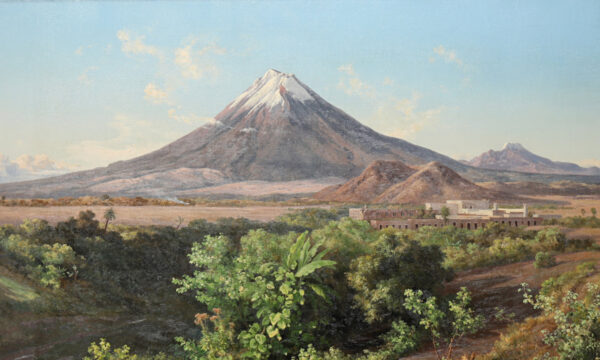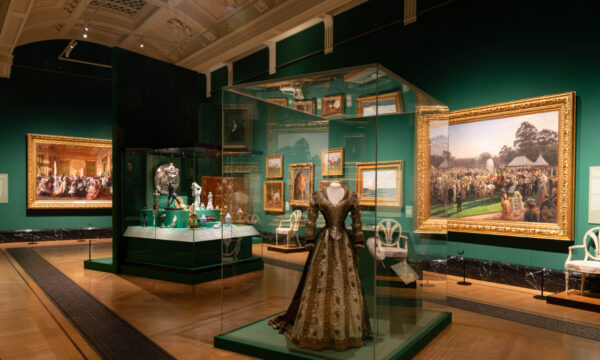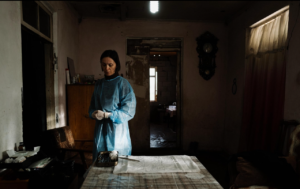Dorothea Tanning: Worlds in Collision at Alison Jacques Gallery

Last year, the Tate Modern’s retrospective of the surrealist Dorothea Tanning’s career revealed her to be an artist of pioneering inventiveness. She was largely overshadowed by her husband Max Ernst during their marriage, but fate would see her survive him by four decades. In recent years, Tanning’s reputation has enjoyed something of an upsurge, with major exhibitions at Reina Sofia, the Tate and The Menil Collection in Houston.
After Ernst’s death in 1976, Tanning in 1980 took the decision to return to the United States and settle in New York, having lived in France for thirty years. Over the next couple of months, Alison Jacques Gallery in Fitzrovia is displaying a series of works she created during the 1980s in the Big Apple. Shown for the first time in the UK, these late pieces are seldom exposed to the public gaze anywhere. Viewers well-versed in Tanning’s oeuvre will pick up on the playfulness that is peculiarly hers. Living in New York for the first time since the 40s certainly invigorated the artist. The large canvas in oil exhibited here, Pounding Strong (1981), is manifestly a reflection on the vibrant, noisy metropolis she had returned to.
Many of the works on the walls of this relatively small but illuminating exhibition feature bicycles. The then septuagenarian artist witnessed an accident involving a bicycle near her studio on the Lower East Side. Clearly the event had an effect on her, as we see the object becoming a recurring motif in her work for a period.
It was 1988 when Tanning started to feature bicycle imagery in a series of works. Many are large paper pieces, rendered in a diverse range of media: charcoal, graphite, crayon, gouache, watercolour and collage. A number have titles that conjure up the severity of the accident she saw: Hell Bent (1988), Reckless (1989) and Tangle (1989), to name a few. They also testify to the artist’s continued exploration of alternative realities, a thread which runs through so much of her practice.
The gouache Between Lives (1989), which briefly appears to half-resemble Duchamp’s Nude Descending a Staircase, No. 2 (1912), depicts two embracing figures, one of whom is piercing the heart of the other. The watercolour Worlds in Collision, bearing the exhibition’s title, has a wild energy, with the two central figures apparently thrown into the air by the force of the impact, their bicycles a distorted whirl of wheels. Whether they are meeting their doom or in a dancing embrace, one cannot be certain.
Dorothea Tanning also sought to engage with the technology which was beginning to reshape the world by the 80s. For Garden with Gardeners, the artist used a new Xerox machine to photocopy ordinary objects like rubber bands, scans of her hand, and sheets with tonal gradations. These were then manipulated to create collage compositions. The work sees Tanning contemplating issues of mass-production and authorship.
This exhibition features a number of the artist’s large charcoal and pastel pieces from her Messages series, produced between 1989 and 1990. These again include the bicycle, that established symbol of modernity, and yet now that motif is placed alongside or interlaced with images of primates. Questions are considered about evolution, humanity’s impact on the planet, and the potency of technology. Tanning spoke of how a bicycle is full of dreams, both fast and slow, whilst the gorilla is full of silence, explaining that she was bringing them together. Alison Jacques Gallery has united this rarely displayed body of late work and the artist emerges as having lost neither her powers of invention nor her enquiring mind.
James White
Featured image: detail from Dorothea Tanning, Worlds in Collision (1988), © Artists Rights Society, New York, and ADAGP, Paris
Dorothea Tanning: Worlds in Collision is at Alison Jacques Gallery from 24th January until 21st March 2020. For further information visit the exhibition’s website here.


























Facebook
Twitter
Instagram
YouTube
RSS